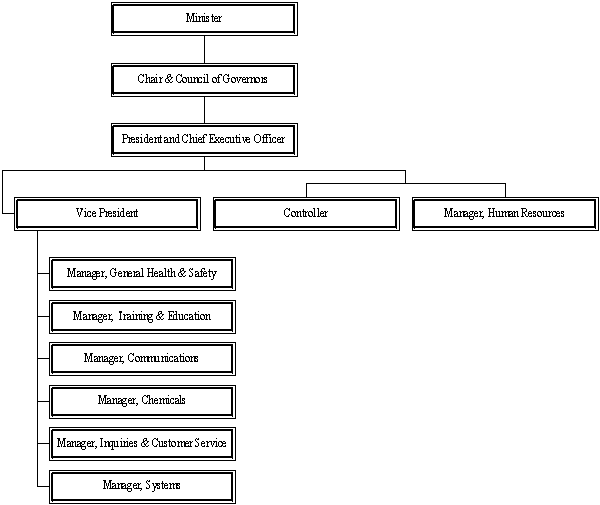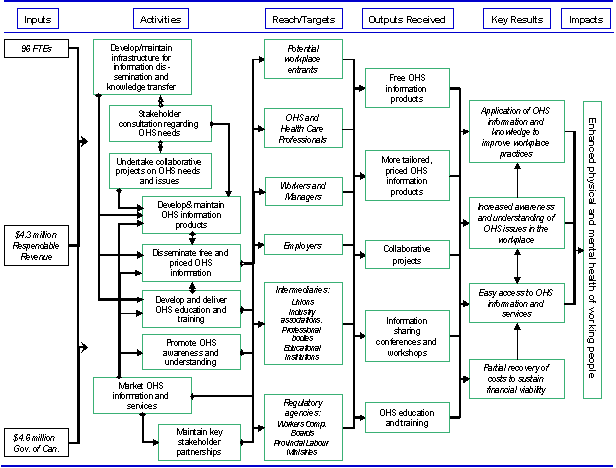Common menu bar links
Breadcrumb Trail
ARCHIVED - Canadian Centre for Occupational Health and Safety
 This page has been archived.
This page has been archived.
Archived Content
Information identified as archived on the Web is for reference, research or recordkeeping purposes. It has not been altered or updated after the date of archiving. Web pages that are archived on the Web are not subject to the Government of Canada Web Standards. As per the Communications Policy of the Government of Canada, you can request alternate formats on the "Contact Us" page.
Section I: Overview
A.Minister's Message
As Canada’s national occupational health and safety resource, the Canadian Centre for Occupational Health and Safety (CCOHS) is uniquely equipped to provide leadership to help foster the much needed shift to a more fully integrated health and safety culture.
As Minister of Labour and Minister of the Economic Development Agency of Canada for the Regions of Quebec, I am proud to present the Centre’s Report on Plans and Priorities for 2008-2009.
CCOHS is Canada’s national occupational health and safety resource which is dedicated to the advancement of occupational health and safety performance by providing services on information and knowledge transfer; training and education; cost-effective tools for improving occupational health and safety performance; management systems services supporting health and safety programs; injury and illness prevention initiatives and promoting the total well-being – physical, psychosocial and mental health - of working people. The Centre was created to provide a common focus for and coordination of information in the area of occupational health and safety. CCOHS focuses on assisting Canadians to use the best available knowledge to improve the prevention of work-related injuries and illnesses.
CCOHS promotes and facilitates consultation and cooperation among federal, provincial and territorial jurisdictions and participation by labour, management and other stakeholders in the establishment and maintenance of high standards and occupational health and safety initiatives for the Canadian context.
It is the fundamental right of all Canadians to a healthy and safe workplace that is the cornerstone to the mandate of CCOHS.
The Honourable Jean-Pierre Blackburn, P.C., M.P.
Minister of Labour and Minister of the Economic Development Agency of Canada for the Regions of Quebec
B.Management Representation Statement
I submit for tabling in Parliament, the 2008-9 Report on Plans and Priorities (RPP) for the Canadian Centre for Occupational Health and Safety.
This document has been prepared based on the reporting principles contained in the Guide for the Preparation of Part III of the 2008-2009 Estimates: Reports on Plans and Priorities and Departmental Performance Reports:
- It adheres to the specific reporting requirements outlined in the Treasury Board Secretariat guidance;
- It is based on the department’s Strategic Outcome and Program Activity Architecture that was approved by the Treasury Board;
- It presents consistent, comprehensive, balanced and reliable information;
- It provides a basis of accountability for the results achieved with the resources and authorities entrusted to it; and
- It reports finances based on approved planned spending numbers from the Treasury Board Secretariat.
Name: S. Len Hong
Title: President and Chief Executive Officer
C.Raison d'être
The Canadian Centre for Occupational Health and Safety was founded by an Act of Parliament in 1978 with a mandate to promote health and safety in the workplace and to enhance the physical and mental health of working people.The Canadian Centre for Occupational Health and Safety (CCOHS) operates under the legislative authority of the Canadian Centre for Occupational Health and Safety Act S.C., 1977-78, c. 29 which was passed by unanimous vote in the Canadian Parliament. The purpose of this Act is to promote the fundamental right of Canadians to a healthy and safe working environment by creating a national institute (CCOHS) concerned with the study, encouragement and co-operative advancement of occupational health and safety.
D. Organizational Information

CCOHS operates as a departmental corporation of the Federal government, and is governed by an independent tripartite Council of Governors comprised of representatives from labour, business, federal, provincial and territorial Canadian governments. This structure helps to ensure that CCOHS remains a well informed and a trusted source of unbiased information for employers, workers and governments.
The internal departments have recently been reorganized. This change will align resources by service and program area so that every area includes the technical, marketing and subject specialists necessary for delivery. Systems will maintain the infrastructure necessary to deliver products and support the products and services developed and the web. The Inquiries Service provides direct free front-line service to Canadians via telephone, fax, mail and Internet. They also provide customer service for cost-recovery products. Communication will continue to promote the use of CCOHS products and services, communications to Canadians and marketing activities. The Controller’s group provides services to the departments including finance, operations support, facilities management and internal computer systems. Human resources support all departments.
E. Program Activity Architecture
Strategic Outcome: Improved workplace conditions and practices that enhance the health, safety and well being of working Canadians.
Program Activity: Occupational health and safety information development, delivery services and tripartite collaboration.
The goal of this program is to provide free information on occupational health and safety to support Canadians in their efforts to improve workplace safety and health. Citizens are provided information through a free and impartial personalized service via telephone, e-mail, person-to-person, fax or mail. Alternatively, they can independently access a broad range of electronic and print resources developed to support safety and health information needs of Canadians. This may include cost recovery products and services and is supported financially by contributions from various stakeholders.
Through health and safety information development, CCOHS collects, processes, analyzes, evaluates, creates and publishes authoritative information resources on occupational health and safety for the benefit of all working Canadians. This information is used for education and training, research, policy development, development of best practices, improvement of health and safety programs, achieving compliance, and for personal use. When the product or service provided by CCOHS is to identifiable external recipients with benefits beyond those enjoyed by the general taxpayer, a user fee is charged.
CCOHS promotes and facilitates consultation and cooperation among federal, provincial and territorial jurisdictions and participation by labour, management and other stakeholders in the establishment and maintenance of high standards and occupational health and safety initiatives for the Canadian context. The sharing of resources results in the coordinated and mutually beneficial development of unique programs, products and services. Collaborative projects are usually supported with a combination of financial and non- financial contributions to the programs by partners and stakeholders and result in advancement of the health and safety initiatives.
F. Voted and Statutory Items listed in Main Estimates
($ thousands)
| 2008-2009 | |||
|---|---|---|---|
| Vote or Statutory Item | Canadian Centre for Occupational Health and Safety | Current Main Estimates | Previous Main Estimates |
| 25 | Program expenditures | 3,682 | 3,560 |
| (S) | Contributions to employee benefit plans | 1,031 | 1,068 |
| Total Agency | 4,713 | 4,628 | |
The increase relates to compensation increases as a result of the change in the collective agreement.
G. Departmental Planned Spending and Full Time Equivalent
| ($ thousands) | Forecast Spending 2007-08 | Planned Spending 2008-09 | Planned Spending 2009-10 | Planned Spending 2010-11 |
|---|---|---|---|---|
| Gross Program Spending: Occupational health and safety information development, delivery services and tripartite collaboration | 8,928 | 9,013 | 9,013 | 9,013 |
| Less: Respendable revenue | 4,300 | 4,300 | 4,300 | 4,300 |
| Total Main Estimates | 4,628 | 4,713 | 4,713 | 4,713 |
| Adjustments: | ||||
| Compensation | 126 | - | - | - |
| Carry forward | 187 | - | - | - |
| Total Adjustments | 313 | - | - | - |
| Net Planned Spending | 4,941 | 4,713 | 4,713 | 4,713 |
| Plus: Cost of Services Provided by other Departments or Agencies | 1,175 | 1,175 | 1,175 | 1,175 |
| Net Cost of Program | 6,116 | 5,888 | 5,888 | 5,888 |
| Full Time Equivalents | 90 | 96 | 96 | 96 |
The changes in planned spending represent funds from compensation increases. Cost of services provided by other departments reflects the contributions covering the employer’s share of employees’ insurance premiums and expenditures paid by Treasury Board of Canada Secretariat.
H.Summary Information
| 2008-2009 | 2009-20010 | 2010-2011 |
|---|---|---|
| $ 4,713 | $ 4,713 | $ 4,713 |
| 2008-2009 | 2009-2010 | 2010-2011 |
|---|---|---|
| 96 | 96 | 96 |
|
Strategic Outcome: Canadians will be provided with unbiased occupational health and safety information and services for the prevention of work-related illnesses and injuries. Program Activity: Occupational health and safety information development, delivery services and tripartite collaboration. |
||||
| Expected Results - Use appropriated funding for | Type | Planned Spending ($000) | ||
|---|---|---|---|---|
| 2008-2009 | 2009-2010 | 2010-2011 | ||
| Easy access to occupational health and safety information and services | ongoing | $1,178 | $1,178 | $1,178 |
| Application of occupational health and safety (OHS) information to improve workplace practices | ongoing | $1,178 | $1,178 | $1,178 |
| Increased awareness and understanding of occupational health and safety issues in the workplace | ongoing | $1,178 | $1,178 | $1,178 |
| Partial recovery of costs from user fees (raise other revenues) | ongoing | $1,179 | $1,179 | $1,179 |
The presentation of the expected results has been aligned to focus on the key results expected in relation to the strategic outcome. The programs of CCOHS are aligned to achieve these inter-dependent key results. The logic model in Exhibit 1 shows the relationship of our various programs and activities to the achievement of key results. The model shows that there is inter-relationship between activities and outputs to the key results. As CCOHS is an information-based organization that also generates revenues from information, these inter-relationships are necessary to ensure the efficient use of limited human and financial resources. Revenue generation from cost- recovery is necessary as our programs are only partially funded through appropriations.
As CCOHS has one program activity and strategic outcome, the performance reporting is presented based upon our expected results. Financial resources reflect an equal allocation between expected results due to the inter-relationship. CCOHS is a small organization where resources and staffing are shared amongst various programs.

